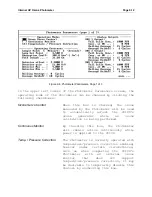
Internal UV Ozone Photometer
Page 9-24
Leak Check
Leaks can develop due to the deformation of seals or by
loosening of connections due to vibration. A leak within the
Photometer assembly or in the pneumatic path before the
Photometer can result in erratic or low span readings. A leak
between the Photometer and pump can result in low flow or
erroneous pressure indications.
The following procedure may be followed to test the Photometer
sample path for leaks:
[1] With the Model
2010D
powered off and disconnected from
power, remove the cover from the unit and put it aside.
[2] Using a 9/16” wrench, disconnect the hose connected to
the fitting labeled Vacuum Source as shown on Figure 9-9.
[3] Using a 9/16” wrench, remove the 3-Way valve connection
from the sample tee and plug the horizontal port with a
suitable cap. Refer to Figure 9-9 for details.
[4] Apply the vacuum source and monitor for any loss. The
vacuum source should read approximately 15 inHg and the
system should maintain the initial value for a few
minutes to insure system integrity.
[5] If there appears to be a leak, make sure that the sample
column bushing and fittings are pressing the o-rings
sufficiently to maintain a proper seal. The compression
on the o-rings can be changed by screwing the fitting
side of the sample column out. Do not adjust the
placement of the bushing or fitting by loosening the set
screws unless it is absolutely necessary for proper 0-
ring compression.
[6] Replace all connections and place the cover back on the
calibrator.
Summary of Contents for 2010D
Page 1: ...MODEL 2010D GAS DILUTION CALIBRATOR OPERATIONS MANUAL I N S T R U M E N T S...
Page 3: ......
Page 20: ...System Operations Page 3 2 Figure 3 1 The Model 2010D Front Panel...
Page 42: ...Installation Page 4 15 Figure 4 1 Rear Panel...
Page 63: ...Operation Page 5 7 Figure 5 5 The Dilution Status Screen Figure 5 6 The Ozone Status Screen...
Page 177: ...MODEL 2010D GAS DILUTION CALIBRATOR SCHEMATICS...
Page 178: ......








































